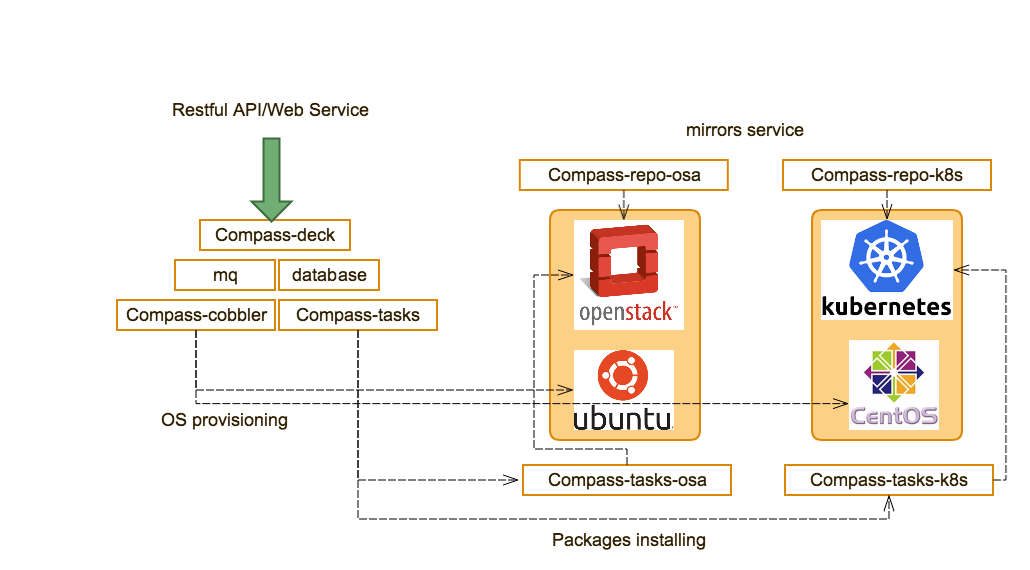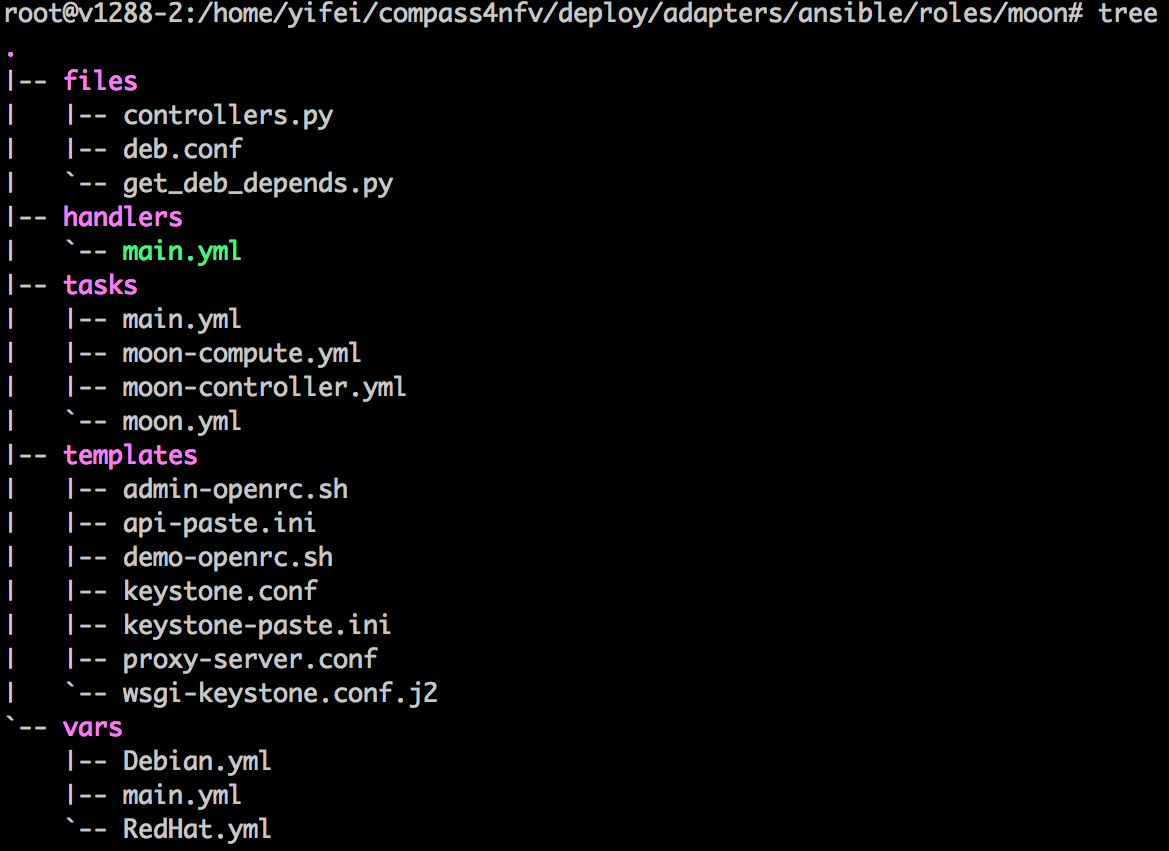Compass4NFV¶
Compass4NFV Development Overview¶
Introduction of Containerized Compass¶
Containerized Compass uses five compass containers instead of a single VM.
Each container stands for a micro service and compass-core function separates into these five micro services:
- Compass-deck : RESTful API and DB Handlers for Compass
- Compass-tasks : Registered tasks and MQ modules for Compass
- Compass-cobbler : Cobbler container for Compass
- Compass-db : Database for Compass
- Compass-mq : Message Queue for Compass
Compass4nfv has several containers to satisfy OPNFV requirements:
- Compass-tasks-osa : compass-task’s adapter for deployment OpenStack via OpenStack-ansible
- Compass-tasks-k8s : compass-task’s adapter for deployment Kubernetes
- Compass-repo-osa-ubuntu : optional container to support OPNFV offfline installation via OpenStack-ansible
- Compass-repo-osa-centos : optional container to support OPNFV offfline installation via OpenStack-ansible
Picture below shows the new architecture of compass4nfv:

Fig 1. New Archietecture of Compass4nfv
Compass4nfv Design Guide¶
1. How to integrate a feature into compass4nfv¶
This document describes how to integrate a feature (e.g. sdn, moon, kvm, sfc) into compass installer. Follow the steps below, you can achieve the goal.
1.1. Create a role for the feature¶
Currently Ansible is the main packages installation plugin in the adapters of Compass4nfv, which is used to deploy all the roles listed in the playbooks. (More details about ansible and playbook can be achieved according to the Reference.) The mostly used playbook in compass4nfv is named “HA-ansible-multinodes.yml” located in “your_path_to_compass4nfv/compass4nfv/deploy/ adapters/ansible/openstack/”.
Before you add your role into the playbook, create your role under the directory of “your_path_to_compass4nfv/compass4nfv/deploy/adapters/ansible/roles/”. For example Fig 1 shows some roles currently existed in compass4nfv.

Fig 1. Existed roles in compass4nfv
Let’s take a look at “moon” and understand the construction of a role. Fig 2 below presents the tree of “moon”.

Fig 2. Tree of moon role
There are five directories in moon, which are files, handlers, tasks, templates and vars. Almost every role has such five directories.
For “files”, it is used to store the files you want to copy to the hosts without any modification. These files can be configuration files, code files and etc. Here in moon’s files directory, there are two python files and one configuration file. All of the three files will be copied to controller nodes for some purposes.
For “handlers”, it is used to store some operations frequently used in your tasks. For example, restart the service daemon.
For “tasks”, it is used to store the task yaml files. You need to add the yaml files including the tasks you write to deploy your role on the hosts. Please attention that a main.yml should be existed as the entrance of running tasks. In Fig 2, you can find that there are four yaml files in the tasks directory of moon. The main.yml is the entrance which will call the other three yaml files.
For “templates”, it is used to store the files that you want to replace some variables in them before copying to hosts. These variables are usually defined in “vars” directory. This can avoid hard coding.
For “vars”, it is used to store the yaml files in which the packages and variables are defined. The packages defined here are some generic debian or rpm packages. The script of making repo will scan the packages names here and download them into related PPA. For some special packages, section “Build packages for the feature” will introduce how to handle with special packages. The variables defined here are used in the files in “templates” and “tasks”.
Note: you can get the special packages in the tasks like this:
- name: get the special packages' http server
shell: awk -F'=' '/compass_server/ {print $2}' /etc/compass.conf
register: http_server
- name: download odl package
get_url:
url: "http://{{ http_server.stdout_lines[0] }}/packages/odl/{{ odl_pkg_url }}"
dest: /opt/
1.2. Build packages for the feature¶
In the previous section, we have explained how to build the generic packages for your feature. In this section, we will talk about how to build the special packages used by your feature.

Fig 3. Features building directory in compass4nfv
Fig 3 shows the tree of “your_path_to_compass4nfv/compass4nfv/repo/features/”. Dockerfile is used to start a docker container to run the scripts in scripts directory. These scripts will download the special feature related packages into the container. What you need to do is to write a shell script to download or build the package you want. And then put the script into “your_path_to_compass4nfv/compass4nfv/repo/features/scripts/”. Attention that, you need to make a directory under /pkg. Take opendaylight as an example:
mkdir -p /pkg/odl
After downloading or building your feature packages, please copy all of your packages into the directory you made, e.g. /pkg/odl.
Note: If you have specail requirements for the container OS or kernel vesion, etc. Please contact us.
After all of these, come back to your_path_to_compass4nfv/compass4nfv/ directory, and run the command below:
./repo/make_repo.sh feature # To get special packages
./repo/make_repo.sh openstack # To get generic packages
When execution finished, you will get a tar package named packages.tar.gz under “your_path_to_compass4nfv/compass4nfv/work/repo/”. Your feature related packages have been archived in this tar package. And you will also get the PPA packages which includes the generic packages you defined in the role directory. The PPA packages are xenial-newton-ppa.tar.gz and centos7-newton-ppa.tar.gz, also in “your_path_to_compass4nfv/compass4nfv/work/repo/”.
1.3. Build compass ISO including the feature¶
Before you deploy a cluster with your feature installed, you need an ISO with feature packages, generic packages and role included. This section introduces how to build the ISO you want. What you need to do are two simple things:
Configure the build configuration file
The build configuration file is located in “your_path_to_compass4nfv/compass4nfv/build/”. There are lines in the file like this:
export APP_PACKAGE=${APP_PACKAGE:-$FEATURE_URL/packages.tar.gz}
export XENIAL_NEWTON_PPA=${XENIAL_NEWTON_PPA:-$PPA_URL/xenial-newton-ppa.tar.gz}
export CENTOS7_NEWTON_PPA=${CENTOS7_NEWTON_PPA:-$PPA_URL/centos7-newton-ppa.tar.gz}
Just replace the $FEATURE_URL and $PPA_URL to the directory where your packages.tar.gz located in. For example:
export APP_PACKAGE=${APP_PACKAGE:-file:///home/opnfv/compass4nfv/work/repo/packages.tar.gz}
export XENIAL_NEWTON_PPA=${XENIAL_NEWTON_PPA:-file:///home/opnfv/compass4nfv/work/repo/xenial-newton-ppa.tar.gz}
export CENTOS7_NEWTON_PPA=${CENTOS7_NEWTON_PPA:-file:///home/opnfv/compass4nfv/work/repo/centos7-newton-ppa.tar.gz}
Build the ISO
After the configuration, just run the command below to build the ISO you want for deployment.
./build.sh
1.4. References¶
Ansible documentation: http://docs.ansible.com/ansible/index.html>
